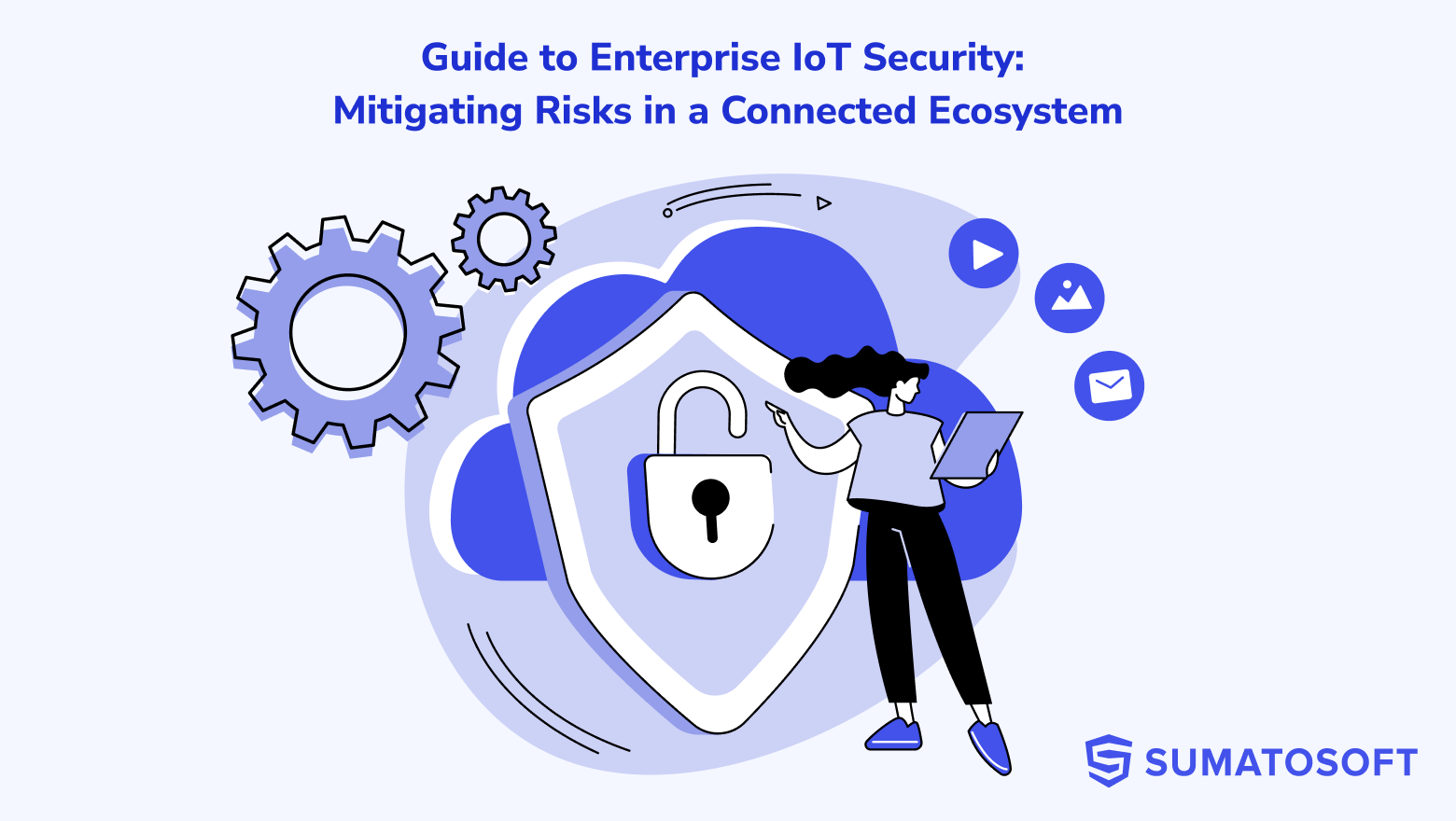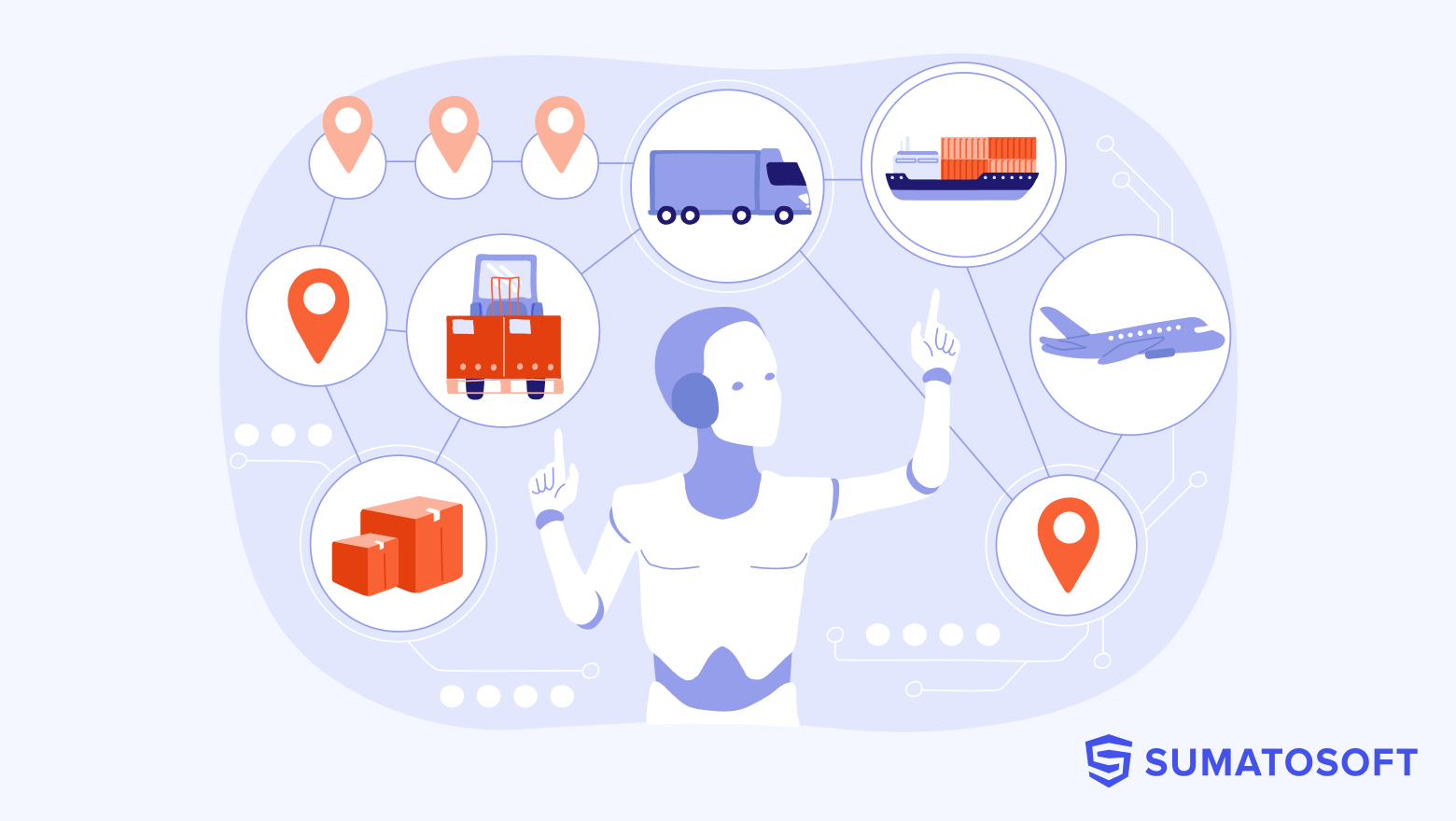IoT Design: Building Principles, Challenges, Examples for 2025


That statement can be applied to IoT design. IoT would have been considered a miracle a few decades ago. Nowadays, it is a reality that gives us carsharing and electric scooter sharing, fitness bands, interconnected manufacturing, smart logistics with real-time truck tracking, autonomous warehouses, and brings much more awesome advantages to various industries.
We have been watching the development of IoT technology for quite a long time. As a software development company, we at SumatoSoft also actively leverage IoT technology when building solutions for our clients. We have gone hand in hand with IoT for almost ten years, building solutions with it, writing articles about it using best essay writing service, and just following the news. We want to say that this technology is truly amazing.
In that article we want to discuss the term “IoT design”, list steps necessary to achieve outstanding IoT design, name main design principles, and show you several curious examples of great IoT design. To get into the spirit of the Internet of Things design, we need to understand the main idea of that technology. That is what our first paragraph will be about.
Enjoy reading!
What is Internet of Things (IoT)?
The Internet of Things stands for two terms:
- the Internet
- things
The Internet is a network of interconnected computers worldwide that can communicate with each other. Things are some physical devices like sensors, smartphones, and fitness trackers.
If we combine these two terms we get the term Internet of Things which means a network of physical devices.
An indispensable element in that term is the word “connected” because an IoT system only exists when its gadgets (or IoT fleet) are connected through the Internet. If we break the connection and separate all gadgets, the IoT system stops existing and loses its benefits.
Thus, speaking about the IoT, we speak about the connectivity of its things. The more things are plugged in, the stronger the network is.
The number of connected devices worldwide is astonishing – 13 billion various things were registered in the global IoT network at the beginning of 2023! This number exceeds the general human population almost twice!
10 millions smart things around the globe!
However, this technology is not just about devices. The vast IoT ecosystem counts up to 7 components in its architecture. Let’s clarify them!
7 Components of IoT Architecture
Major the Internet of Things components are:
- devices
- network
- Cloud
Keeping them in mind, you can build a simple IoT ecosystem. However, the more sophisticated system you want to develop, the more components you need to utilize.
If we look into the most featured IoT architecture, we find the next 7 components.
#1 component: IoT devices
are the core element of any network. They are physical devices that connect wirelessly to an IoT network and have the ability to transmit data over the Internet.
#2 component: The network
is a binder between all devices. The network is represented by communication protocols and methods that allow gadgets to communicate with each other, transfer data, and connect to the cloud.
#3 component: Security
is a vital component since it manages the access to the IoT network from outside the system, prevents data leakage, and much more. The security component can be critical for large industrial applications that leverage the IoT in production, thus becoming dependent on the robust work of the whole system. Companies that produce mass products for smart homes or personal usage also should pay special attention to that component, since the privacy of their customers must be a top priority.
#4 component: Gateway
can be taken literally like a gate that you need to pass through. It is a physical device or virtual platform that connects sensors, IoT modules, and smart devices to the cloud.
#5 component: Cloud
is the brain of IoT. It refers to cloud computing technologies that store data, and use various methods to analyze and manage the data. A cloud is a place where data is transformed from an unstructured mess of information into a nice flow of valuable insights. Empowered by Big Data and Machine learning, the cloud brings to us awesome phenomena like predictive maintenance, automation, and much more.
#6 component: Application
is a graphical interface that allows users, business owners, employees, and other people to communicate with an IoT system, manage its fleet, check the status, etc.
#7 component: Users
are all people who influence the Internet of Things system and reap the benefits.
With the help of these components, you can describe any IoT system. However, knowing the structure is not everything. This is a theory, while you need mastery to design a high-quality IoT solution. Here we come to the term IoT design.
IoT Design Meaning
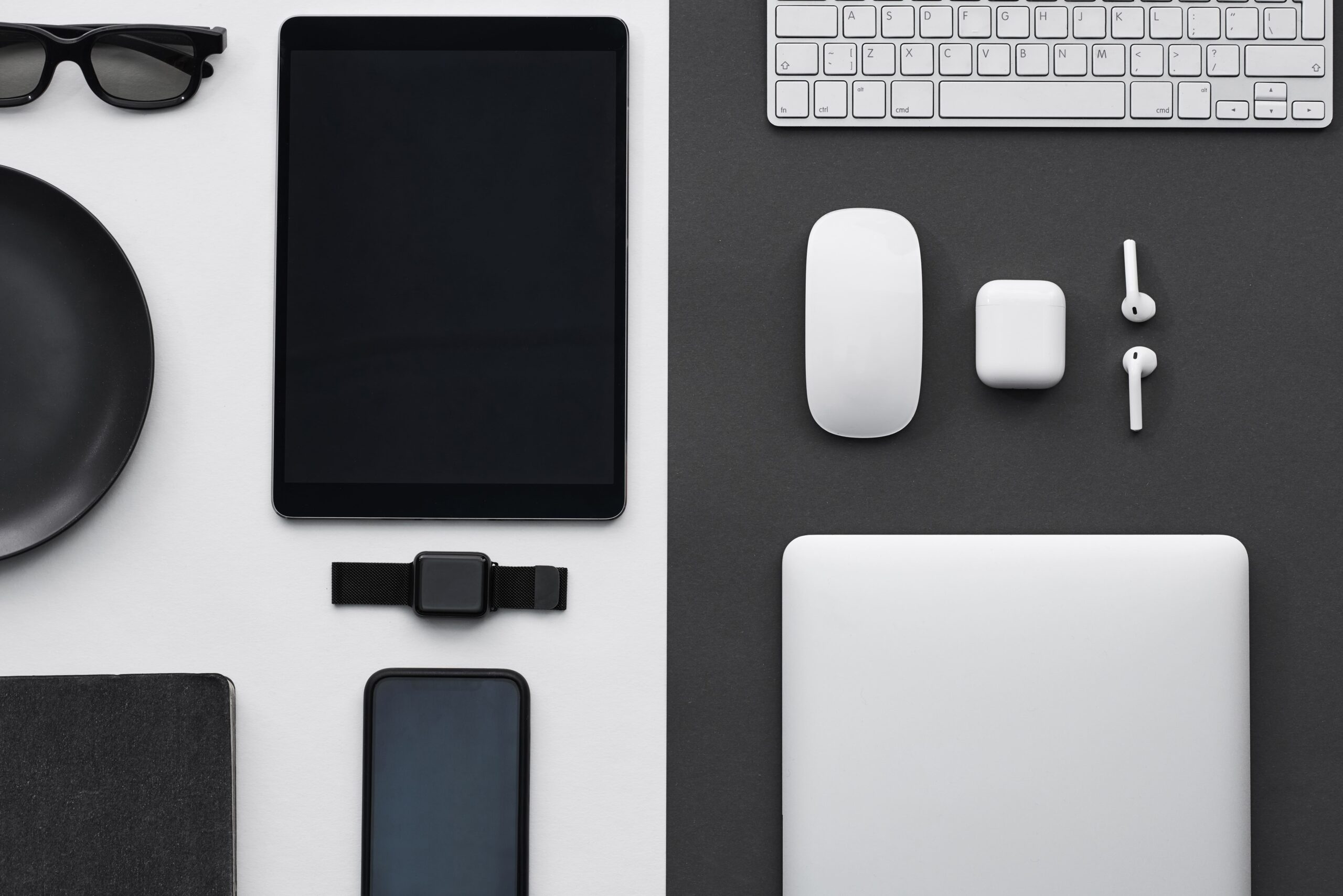
The Internet of Things design is a special approach to building every part of the IoT architecture. Usual methods to manage, store, and transfer data are not enough to handle the data within the IoT ecosystem (read about that in the article IoT and Big Data). The development approach must be adopted to the peculiarities of the Internet of Things. A single network can count thousands or more connected gadgets, user interfaces in IoT require new design practices, the experience of IoT users differs from the experience of web users, interactions and contact points between users and IoT systems are unique.
The IoT design approach is an approach to the IoT system development with respect to the peculiarities of the Internet of Things. That term covers all components of IoT architecture from IoT devices and their hardware to applications and user interfaces. The term Internet of Things design includes shapes of devices, their material, color scheme, a cloud service provider, modules, applications, and much more.
Main Challenges in IoT Design

- Privacy – with IoT devices collecting vast amounts of data, sometimes of a personal nature, ensuring privacy is a key challenge. This includes securing data in transit and at rest, as well as ensuring appropriate use of the data.
- Interoperability – IoT devices use different communication protocols and standards. Ensuring that these devices can seamlessly connect and communicate with each other is a critical issue.
- Power Consumption – many IoT devices run on battery and are expected to operate for long periods without needing a recharge. Designing IoT devices with low power consumption is a significant challenge.
- Scalability – the number of IoT devices is growing exponentially. Systems and networks must be designed to handle this increase in scale without a drop in performance.
- Data Management – the vast amounts of data that IoT devices generate need to be efficiently stored, processed, and analyzed. This requires robust data management solutions.
- Connectivity – IoT devices need to stay connected to function properly. Ensuring stable and reliable connectivity in different environments (e.g., rural vs. urban) is a challenge.
- Hardware Limitations – IoT devices often need to be small, cheap, and power-efficient. This imposes constraints on what hardware can be used, which can limit the capabilities of the device.
- Regulation Compliance – complying with different regulations (like GDPR, HIPAA) across different regions can be quite challenging considering the diverse nature of IoT applications.
- Integration Challenges – IoT devices need to be integrated with existing systems, networks, and applications. Ensuring smooth integration without disrupting current operations can be difficult.
4 Steps to Astounding IoT Design
It would take an entire book to cover this topic. In that regard, we won’t go into describing the details of each step. Instead, we will help you get a comprehensive picture of what Internet of Things design is all about.
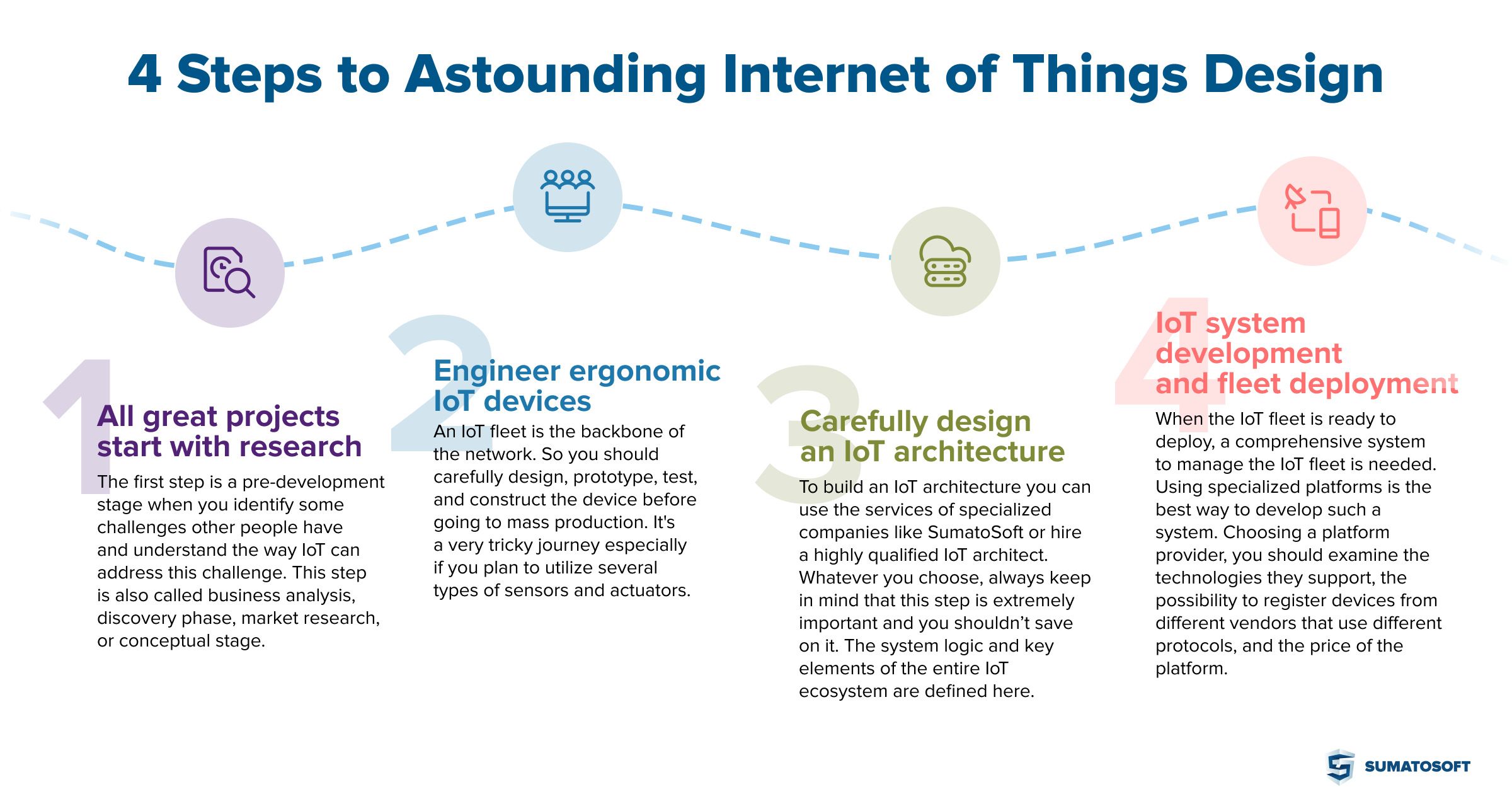
#1 Step: All great projects start with research
The first step is a pre-development stage when you identify some challenges other people have and understand the way IoT can address these challenges. This step is also called business analysis, discovery phase, market research, or conceptual stage. You need to understand what needs your future solution meets, identify the audience and ways to reach them, create profiles of your users, describe distribution channels, find partners, draft a financial plan, and much more. You also need to browse the market and look at similar existing solutions. Consider yourself a startup that needs to pass the first startup development stage.
#2 Step: Engineer ergonomic IoT devices
An IoT fleet is the backbone of the network. So you should carefully design, prototype, test, and construct the device before going to mass production. It’s a very tricky journey especially if you plan to utilize several types of sensors and actuators. A device for final users (like fitness trackers) must be ergonomic, and simple-in-use, while for industrial gadgets one of the biggest challenges is battery life. It’s also necessary to find a reliable device vendor that has enough experience in IoT fleet management and production.
In addition to all of the above, you need to understand whether your solution is possible to build using IoT devices. IoT affects various industries, and devices in some industries like healthcare are very complicated since the accuracy of these devices must be close to 100%, and interruptions in operation can lead to people’s death – so it requires a lot of financing and expertise. On the other side, if your idea is connected with Smart Homes, it will be much easier to find a device manufacturer or build a device on your own. Balance your desires with possibilities.
#3 Step: Carefully design an IoT architecture
To build an IoT architecture you can use the services of specialized companies like SumatoSoft or hire a highly qualified IoT architect. Whatever you choose, always keep in mind that this step is extremely important and you shouldn’t save on it. The system logic and key elements of the entire IoT ecosystem are defined here. Pay special attention to network characteristics and technologies since they must cope with the traffic volume it carries. Define the types of data that it is going to transmit: voice, video, pictures, text, etc. Dealing with IoT traffic entails the presence of special network requirements.
#4 Step: IoT system development and fleet deployment
When the IoT fleet is ready to deploy, a comprehensive system to manage the IoT fleet is needed. Using specialized platforms is the best way to develop such a system. Choosing a platform provider, you should examine the technologies they support, the possibility to register devices from different vendors that use different protocols, and the price of the platform.
Before the fleet deployment, you need to create an instance of every device in the system, record the information about each device, provide secure residentials for every device, set up permissions and access rights, and much more. Device onboarding can become a tricky issue without the right platform for IoT fleet management. While the right platform can increase production throughput and help to achieve a fourfold increase in device provisioning throughput.
Best IoT platforms are:
- HomeKit
- AWS IoT Device Management Services
- Azure IoT Suite
- Oracle IoT
In case you work with the mass market, an additional step here is building a fast and user-friendly application. The application development lifecycle consists of designing and prototyping, programming, testing, and releasing the application.
9 Best IoT Design Principles
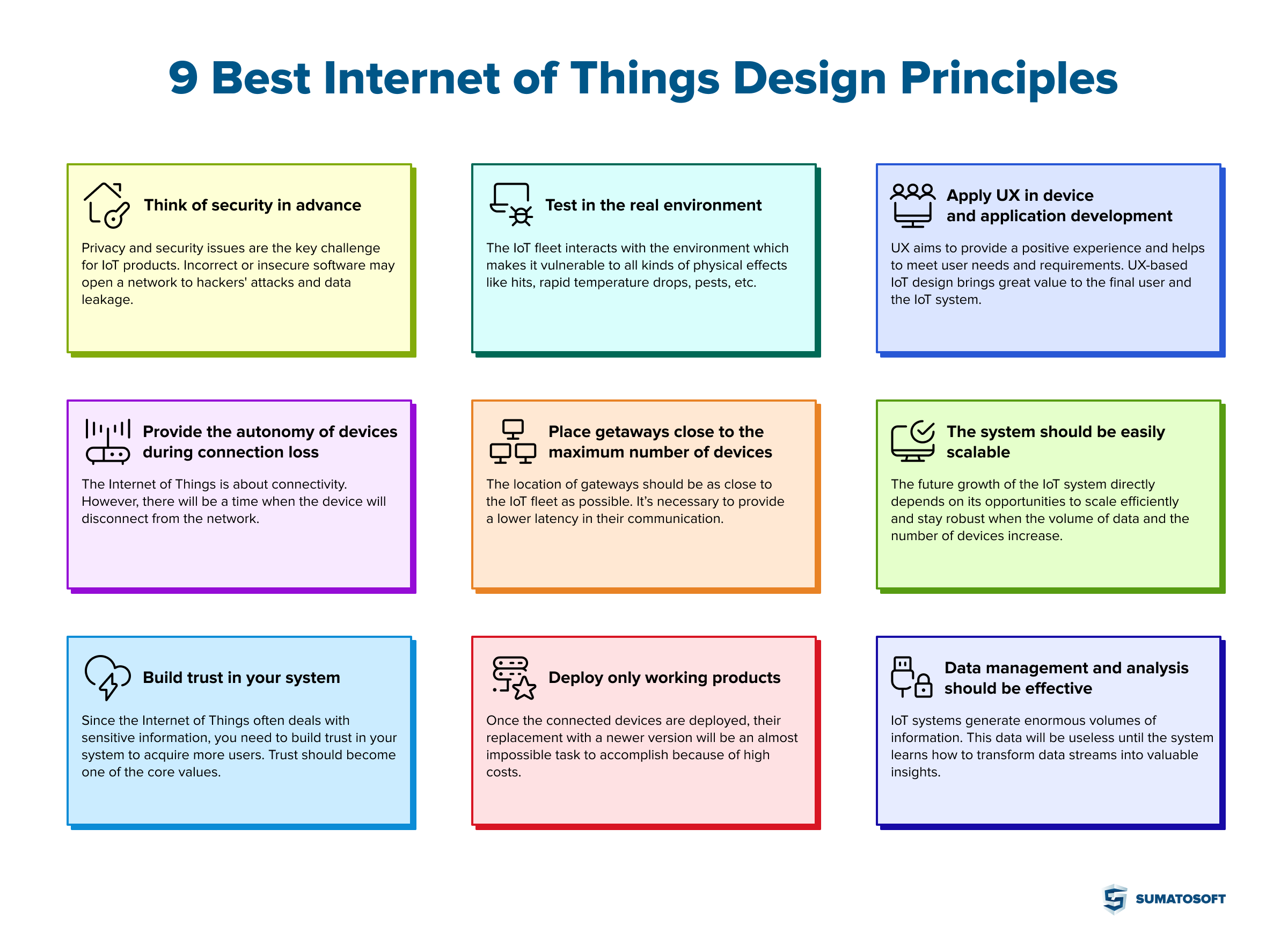
#1 Principle: Think of security in advance
Privacy and security issues are the key challenge for IoT products. Incorrect or insecure software may open a network to hackers’ attacks and data leakage. In addition, there is a need to establish proper security update processes as a part of IoT update management to deploy security patches effectively and quickly.
#2 Principle: Test in the real environment
The IoT fleet interacts with the environment which makes it vulnerable to all kinds of physical effects like hits, rapid temperature drops, pests, etc. All these treats are hard to test in laboratory conditions, so it’s necessary to test devices in a real environment where they are supposed to work further.
#3 Principle: Apply UX in device and application development
UX aims to provide a positive experience and helps to meet user needs and requirements. UX-based IoT design brings great value to the final user and the IoT system.
#4 Principle: Provide the autonomy of devices during connection loss
The Internet of Things is about connectivity. However, there will be a time when the device will disconnect from the network. The device should continue to work properly and transfer the collected information when the connection will be restored.
#5 Principle: Place getaways close to the maximum number of devices

The location of gateways should be as close to the IoT fleet as possible. It’s necessary to provide a lower latency in their communication.
#6 Principle: The system should be easily scalable
The future growth of the IoT system directly depends on its opportunities to scale efficiently and stay robust when the volume of data and the number of devices increase.
#7 Principle: Build trust in your system
Since the Internet of Things often deals with sensitive information, you need to build trust in your system to acquire more users. Trust should become one of the core values.
#8 Principle: Deploy only working products
Once the connected devices are deployed, their replacement with a newer version will be an almost impossible task to accomplish because of high costs. That means that one single error in the fleet which is detected after the fleet deployment can lead to large financial losses. Due to that, it’s good to avoid untested hardware iterations and deploy only working products.
#9 Principle: Data management and analysis should be effective
IoT systems generate enormous volumes of information. This data will be useless until the system learns how to transform data streams into valuable insights. It is up to effective data management and analysis whether the IoT system will generate value or just become a data warehouse.
The Significance of the Ethical Aspect in IoT Design

As IoT devices and applications become more prevalent, it’s important to consider the ethical implications of IoT design. Some key ethical considerations include privacy, security, data ownership, and transparency.
For example, imagine a smart home security system that uses cameras and sensors to monitor a family’s activity. While the system may be effective in preventing theft or intruders, it could also collect personal data about the family’s daily routines and habits, which could be used for nefarious purposes if it falls into the wrong hands.
How IoT engineers can address this issue:
- Implement security measures: IoT designers should implement security measures such as encryption and authentication to protect user data from unauthorized access.
- Develop transparent data policies: IoT designers should develop transparent data policies that clearly explain what data is being collected and how it will be used, as well as obtain user consent before collecting any personal data.
- Consider the impact on vulnerable populations: IoT designers should consider the potential consequences of their designs, particularly for vulnerable populations such as children, the elderly, or people with disabilities, and work to ensure that their products are accessible and inclusive to all users.
- Prioritize privacy by design: IoT designers should prioritize privacy by design, which involves incorporating privacy considerations into the design process from the beginning, rather than as an afterthought.
- Educate users: IoT designers should provide clear and concise instructions on how to use their products safely and securely, as well as provide resources for users to learn more about IoT security and privacy best practices.
Great IoT Design Examples
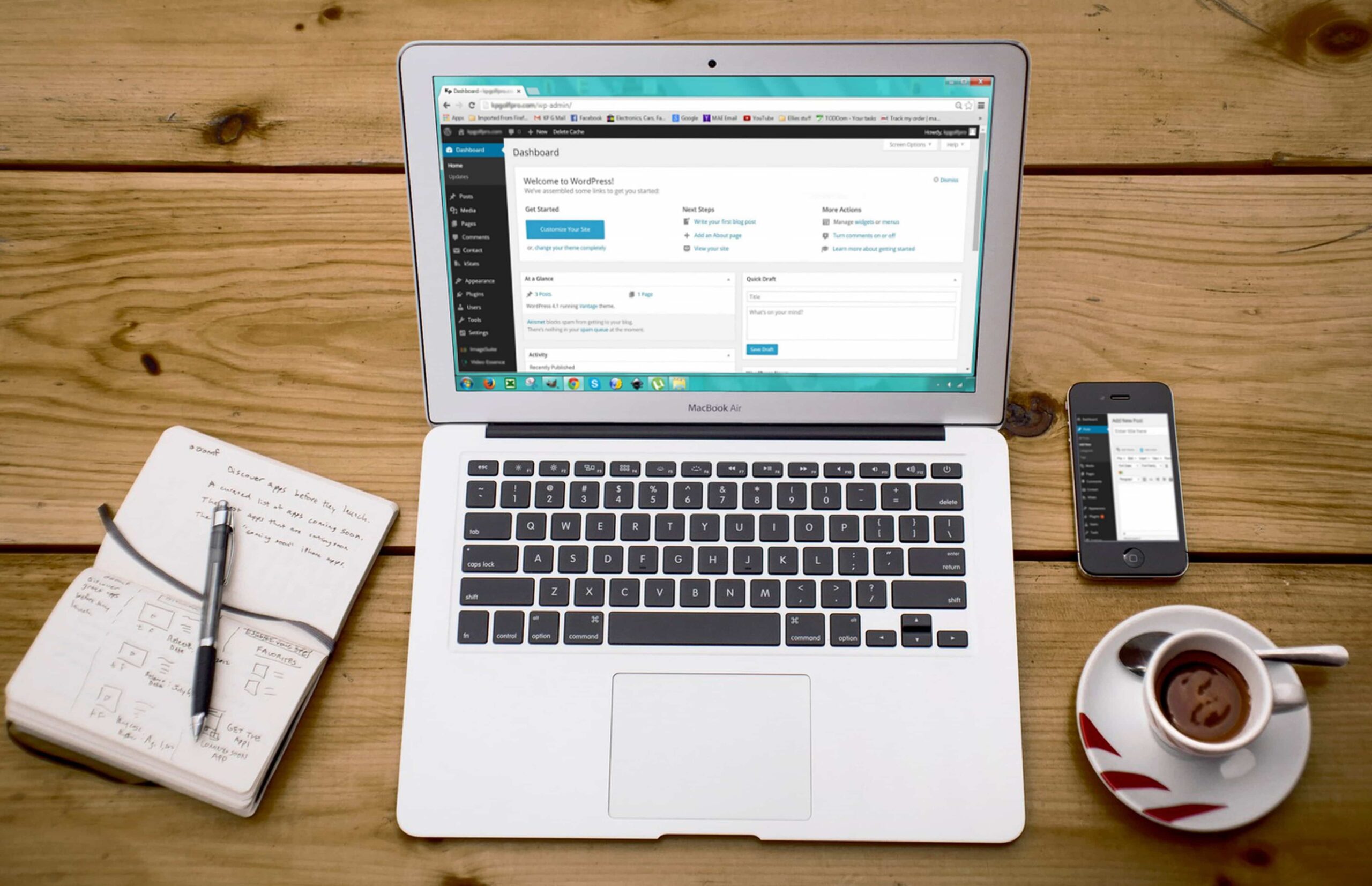
Building a great IoT design is not an easy task. However, we managed to find 3 breathtaking examples that managed to follow our principles above.
Whistle – Better tech for better care
Whistle is an application that connects to the IoT device on a pet through the cellular network. Its goal is to take care of the pets by providing precise data to their owners. The IoT device monitors key behaviors like scratching, drinking, sleep, licking, and other activities. Then it analyzes them and assigns a score to the pet’s health. The scoring system leverages machine learning methods and health stories from 100 000 + dogs to evaluate a pet’s behavior and track its wellness.
Keymitt – Smart locks for your doors
Keymitt offers smart door locks with voice assistance. The Keymitt application is very convenient and user-friendly, and it is compatible with Android and iOS smartphones. This IoT solution is much safer than ordinary door locks because it ensures privacy and secure access thanks to real-time notifications of the owner. Moreover, smart locks have one great advantage compared to traditional locks – your application is responsible for lock control, there is no need to hold keys.
August Smart Lock Pro – Key-free access to your home
The August Smart Lock Pro is a smart lock that allows users to remotely control their door locks using their smartphones. It integrates with popular smart home platforms like Alexa and Google Assistant, allowing users to lock and unlock their doors with voice commands. The smart lock also includes a range of security features, such as two-factor authentication and activity alerts, to ensure that the user’s home is secure. The lock also allows users to provide temporary access to guests or service providers through the August app, making it easy to grant and revoke access as needed.
Final Words From SumatoSoft
The Internet of Things is an awesome technology that helps to change the world. However, technology also needs to evolve – that is why the Internet of Things design appeared. Although every IoT system is unique, interacts with numerous devices of different types, and has various architectures, IoT design comprises the most efficient principles and practices that facilitate the system to bring value and meaningful user experience.
We have worked with the Internet of Things technology for more than 10 years and have got great expertise and experience in building comprehensive enterprise applications as well as helping startup companies to develop their first applications.
Get in touch with us!
Let’s start
If you have any questions, email us info@sumatosoft.com

